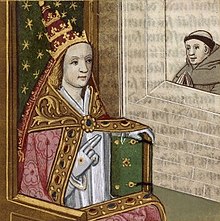Our website is made possible by displaying online advertisements to our visitors.
Please consider supporting us by disabling your ad blocker.
Pope Joan


Pope Joan (Ioannes Anglicus, 855–857) was an anti-Catholic legend about a woman who purportedly reigned as pope for two years during the Middle Ages.[1] Her story first appeared in chronicles in the 13th century and subsequently spread throughout Europe. The story was widely believed for centuries, but most modern scholars regard it as fictional.[2][3][4]
Most versions of her story describe her as a talented and learned woman who disguised herself as a man, often at the behest of a lover. In the most common accounts, owing to her abilities she rose through the church hierarchy and was eventually elected pope. Her sex was revealed when she gave birth during a procession and she died shortly after, either through murder or natural causes. The accounts state that later church processions avoided this spot and that the Vatican removed the female pope from its official lists and crafted a ritual to ensure that future popes were male.[5][6] In the 16th century, Siena Cathedral featured a bust of Joan among other pontiffs; this was removed after protests in 1600.[7]
Jean de Mailly's chronicle, written around 1250, contains the first mention of an unnamed female pope and inspired several more accounts over the next several years. The most popular and influential version is that interpolated into Martin of Opava's Chronicon Pontificum et Imperatorum later in the 13th century. Martin introduced details that the female pope's birth name was John Anglicus of Mainz, that she reigned in the 9th century and that she entered the church to follow her lover.[8] The existence of Pope Joan was used in the defence of Walter Brut in his trial of 1391.[9] The legend was generally accepted as true until the 16th century, when a widespread debate among Catholic and Protestant writers called the story into question: various writers noted the implausibly long gap between Joan's supposed lifetime and her first appearance in texts.[10][11] Protestant scholar David Blondel ultimately demonstrated the impossibility of the story.[12][13] Pope Joan is now widely considered fictional, though the legend remains influential in cultural depictions.[14][15]
- ^ The span is given as 855–857; see also quotes from "The Register of Bishop Trefnan" in The Trial of Walter Brut of 1391 in Blamires, p. 259.
- ^ Boureau, Alain (2001). The Myth of Pope Joan. Translated by Lydia G. Cochrane. University of Chicago Press. p. 8. ISBN 0-226-06745-9.
- ^ Rustici, Craig M. (2006). The Afterlife of Pope Joan: Deploying the Popess Legend in Early Modern England. University of Michigan Press. p. 8. ISBN 978-0-472-11544-0.
- ^ Noble, Thomas F. X. (April 2013). "Why Pope Joan?". Catholic Historical Review. 99 (2): 219–220. doi:10.1353/cat.2013.0078. S2CID 159548215.
- ^ Rustici, Craig M. (2006). The Afterlife of Pope Joan: Deploying the Popess Legend in Early Modern England. University of Michigan Press. pp. 1–2. ISBN 978-0-472-11544-0.
- ^ Noble, Thomas F. X. (April 2013). "Why Pope Joan?". Catholic Historical Review. 99 (2): 220. doi:10.1353/cat.2013.0078. S2CID 159548215.
- ^ Rustici, Craig M. (2006). The Afterlife of Pope Joan: Deploying the Popess Legend in Early Modern England. University of Michigan Press. pp. 12–3. ISBN 978-0-472-11544-0.
- ^ Rustici, Craig M. (2006). The Afterlife of Pope Joan: Deploying the Popess Legend in Early Modern England. University of Michigan Press. pp. 6–7. ISBN 978-0-472-11544-0.
- ^ Blamires, 250–260.
- ^ Rustici, Craig M. (2006). The Afterlife of Pope Joan: Deploying the Popess Legend in Early Modern England. University of Michigan Press. p. 14. ISBN 978-0-472-11544-0.
- ^ Noble, Thomas F. X. (April 2013). "Why Pope Joan?". Catholic Historical Review. 99 (2): 229. doi:10.1353/cat.2013.0078. S2CID 159548215.
- ^ David Blondel, Familier esclaircissement de la question si une femme a este assise au siege papal de Rome entre Leon IV et Benoit III (Amsterdam: Blaeu, 1647); discussed in Valerie R. Hotchkiss, "The Female Pope and the Sin of Male Disguise", in Clothes Make the Man: Female Cross Dressing in Medieval Europe (London: Routledge, 2012), 69. ISBN 1135231710
- ^ Duffy, Eamon (1997). Saints and Sinners: A History of the Popes (Third ed.). New Haven: Yale University Press. p. 158. ISBN 978-0-300-11597-0.
- ^ Rustici, Craig M. (2006). The Afterlife of Pope Joan: Deploying the Popess Legend in Early Modern England. University of Michigan Press. p. 2. ISBN 978-0-472-11544-0.
- ^ Norwich, John Julius (2011). A History of the Papacy. New York: Random House. p. 63. ISBN 978-0-679-60499-0.
Previous Page Next Page


